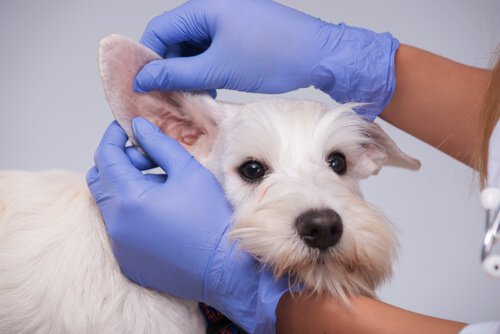Dog Breeds Prone to Ear Infections

Swelling of your pet’s ear canal can be very painful and change his behavior. Therefore, it’s very important to be able to detect it as soon as it appears. It may also be worth knowing what dog breeds are prone to developing ear infections. Read this article if you would to learn more.
What is an Ear Infection?
Start by learning about what this common condition is. Oitis is the inflammation of the ear which can also affect other areas.
Otitis externa is the most common and it develops due to sudden changes in the environment. Otitis media appears as an extension of otitis externa. It is the result of not treating it soon enough and the eardrum ends up bursting. Finally, otitis interna takes place in the internal structures of your dog’s ears.
There are many different causes for this infection. Although any dog can have this medical condition, some breeds are more prone to have it than others. It all depends on their type or size of ear. This is without mentioning that a dog’s ear canal is vertical, which means that a lot of dirt and moisture can build up inside.
Otitis in dogs can also be caused by a build-up of hair or the presence of fungi, parasites, mites, bacteria, or even an allergic reaction to food or medication.
Dogs can also develop otitis due to the buildup of dead skin, a foreign body in the ear canal, diet, plants, or from an autoimmune condition like Hypothyroidism. However, the main cause is the moisture after a bath, swimming in the sea, or playing in the rain.

The main symptoms of otitis are reddening and inflammation of the ear canal, a bad smell coming from the ears, a yellowish-brown secretion, crusting around the edges of the ears, and changes in your dog’s behavior. Other symptoms include constant head-scratching, rubbing against things, or shaking themselves.
Breeds Prone to Ear Infections
Whether or not your dog is prone to having an ear infection, it all depends on his ears, whether he has any skin conditions or the amount of hair around the ears. Dog breeds which are prone to ear infections are the following:
1. Boxer, Irish Setter, Shih Tzu, and West Highland Terrier
In such cases, these dogs suffer from allergic dermatitis, a skin condition that’s caused by their living environment, which may have lots of mites and fleas.
2. Cocker Spaniel, Springer Spaniel, Basset Hound, Beagle, and Bloodhound
All these breeds have one thing in common: droopy ears, which increase their chance of developing otitis. This is because their ear canals are largely covered by their long droopy ears. They can cause a build-up of moisture, bacteria, and mites.
It’s common for these dogs to be constantly scratching their head and moving their ears from one side to another. It’s also common for their ears to smell bad. Pay close attention to them, because this infection — especially in the Cocker Spaniel — can cause them to become very disorientated.
3. Chow Chow
This dog breed has a very narrow ear canal and is therefore prone to infections. These are generally caused by a build of wax or the presence of bacteria or parasites. To find out the cause, you’ll need to analyses the color of the secretions.
4. German Shepherd and Labrador Retriever
For these breeds, otitis is caused by the glandular tissue in the ears that tends to swell, which makes the ear canal narrower.

Both breeds have large ears and this just makes things worse, since any grain of dirt can get lodged in their ears and can’t get out.
5. Schnauzer and Poodle
These final two breeds are prone developing ear infections because of the hairs inside the ear canal. They have very thick hair all over their body. This means that a good haircut can be an effective way of preventing otitis. Furthermore, after a bath, it’s a good idea to use a hair dryer and a towel to stop moisture from getting inside the ears.
This text is provided for informational purposes only and does not replace consultation with a professional. If in doubt, consult your specialist.